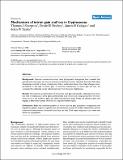Mechanisms of intron gain and loss in Cryptococcus
Author(s)
Neafsey, Daniel E.; Galagan, James E.; Sharpton, Thomas J.; Taylor, John W.
Downloadgb-2008-9-1-r24.pdf (812.6Kb)
PUBLISHER_CC
Publisher with Creative Commons License
Creative Commons Attribution
Terms of use
Metadata
Show full item recordAbstract
Background: Genome comparisons across deep phylogenetic divergences have revealed that spliceosomal intron gain and loss are common evolutionary events. However, because of the deep divergences involved in these comparisons, little is understood about how these changes occur, particularly in the case of intron gain. To ascertain mechanisms of intron gain and loss, we compared five relatively closely related genomes from the yeast Cryptococcus. Results: We observe a predominance of intron loss over gain and identify a relatively slow intron loss rate in Cryptococcus. Some genes preferentially lose introns and a large proportion of intron losses occur in the middle of genes (so called internal intron loss). Finally, we identify a gene that displays a differential number of introns in a repetitive DNA region. Conclusion: Based the observed patterns of intron loss and gain, population resequencing and population genetic analysis, it appears that recombination causes the widely observed but poorly understood phenomenon of internal intron loss and that DNA repeat expansion can create new introns in a population.
Date issued
2008-01Department
Broad Institute of MIT and HarvardJournal
Genome Biology
Publisher
BioMed Central Ltd
Citation
Genome Biology. 2008 Jan 30;9(1):R24
Version: Final published version
ISSN
1474-760X
1465-6914